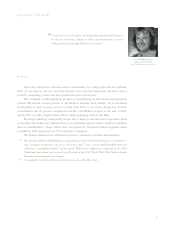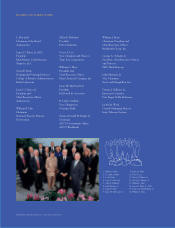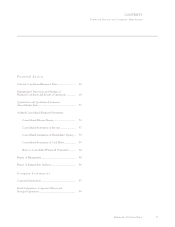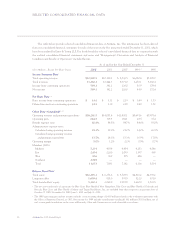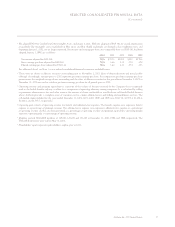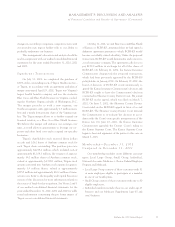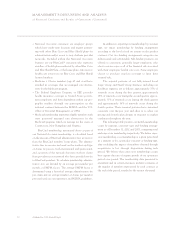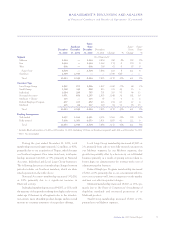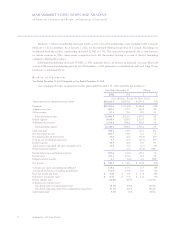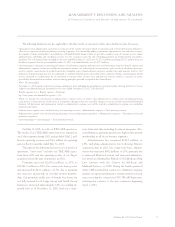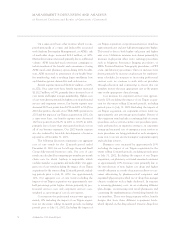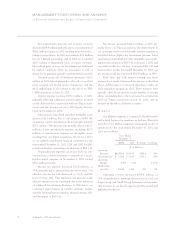Anthem Blue Cross 2002 Annual Report Download - page 33
Download and view the complete annual report
Please find page 33 of the 2002 Anthem Blue Cross annual report below. You can navigate through the pages in the report by either clicking on the pages listed below, or by using the keyword search tool below to find specific information within the annual report.
MANAGEMENT’S DISCUSSION AND ANALYSIS
of Financial Condition and Results of Operations
28 Anthem, Inc. 2002 Annual Report
Introduction
We are one of the nation’s largest health benefits
companies and we operate as an independent licensee of
the Blue Cross Blue Shield Association, or BCBSA. We
offer Blue Cross威Blue Shield威branded products to cus-
tomers throughout Indiana, Kentucky, Ohio, Connecticut,
New Hampshire, Maine, Colorado, Nevada and Virginia
(excluding the Northern Virginia suburbs of Washington,
D.C.). As of December 31, 2002, we provided health
benefit services to more than 11 million members of our
health plans.
Our health business segments are strategic business
units delineated by geographic areas within which we
offer similar products and services. We manage our health
business segments with a local focus to address each mar-
ket’s unique competitive, regulatory and healthcare deliv-
ery characteristics. Our health business segments are:
Midwest, which includes Indiana, Kentucky and Ohio;
East, which includes Connecticut, New Hampshire and
Maine; West, which includes Colorado and Nevada; and
Southeast, which is Virginia, excluding the Northern
Virginia suburbs of Washington D.C.
In addition to our four health business segments, our
reportable segments include a Specialty segment that is
comprised of business units providing group life and dis-
ability insurance benefits, pharmacy benefit management,
dental and vision administration services and behavioral
health benefits services. During the third quarter of 2002,
we sold our third party occupational health services busi-
nesses, which were part of our Specialty segment. The
results of these businesses were not material to earnings of
this segment or our consolidated results.
Our Other segment is comprised of AdminaStar
Federal, a subsidiary that administers Medicare programs
in Indiana, Illinois, Kentucky and Ohio; intersegment
revenue and expense eliminations; and corporate expenses
not allocated to our health or Specialty segments. In
2001, our Other segment also contained Anthem Alliance
Health Insurance Company, or Anthem Alliance. Anthem
Alliance primarily provided health care benefits and
administration in nine states for the Department of
Defense’s TRICARE Program for military families. We
sold our TRICARE operations on May 31, 2001.
We offer a diversified mix of managed care products
such as preferred provider organizations or PPOs, health
maintenance organizations or HMOs, point of service or
POS plans and traditional indemnity benefits to members
of our fully-insured products. We also provide a broad
array of managed care services to self-funded employers,
including claims processing, underwriting, stop loss insur-
ance, actuarial services, provider network access, medical
cost management and other administrative services.
Our operating revenue consists of premiums, admin-
istrative fees and other revenue. The premiums come
from fully-insured contracts where we indemnify our poli-
cyholders against costs for health benefits. Our adminis-
trative fees come from contracts where our customers are
self-insured, from the administration of Medicare pro-
grams and from other health related businesses including
disease management programs. Other revenue is princi-
pally generated from the mail-order sale of drugs by our
pharmacy benefit management company.
Our benefit expense consists of costs of care for
health services consumed by our members for outpatient
care, inpatient care, professional services (primarily
physician care) and pharmacy benefit costs. All four com-
ponents are affected both by unit costs and utilization
rates. Unit costs, for example, are the cost of outpatient
medical procedures, inpatient hospital stays, physician
fees for office visits and prescription drug prices.
Utilization rates represent the volume of consumption of
health services and vary with the age and health of our
members and their social and lifestyle choices, along with
clinical protocols and customs in each of our markets. A
portion of benefit expense for each reporting period con-
sists of actuarial estimates of claims incurred but not yet
reported to us for reimbursement.
Our results of operations depend in large part on our
ability to accurately predict and effectively manage health
care costs through effective contracting with providers of
care to our members. Several economic factors related to
health care costs such as regulatory mandates for coverage
and direct-to-consumer advertising by providers and
pharmaceutical companies have a direct impact on the
volume of care consumed by our members. The potential
effect of escalating health care costs as well as any






